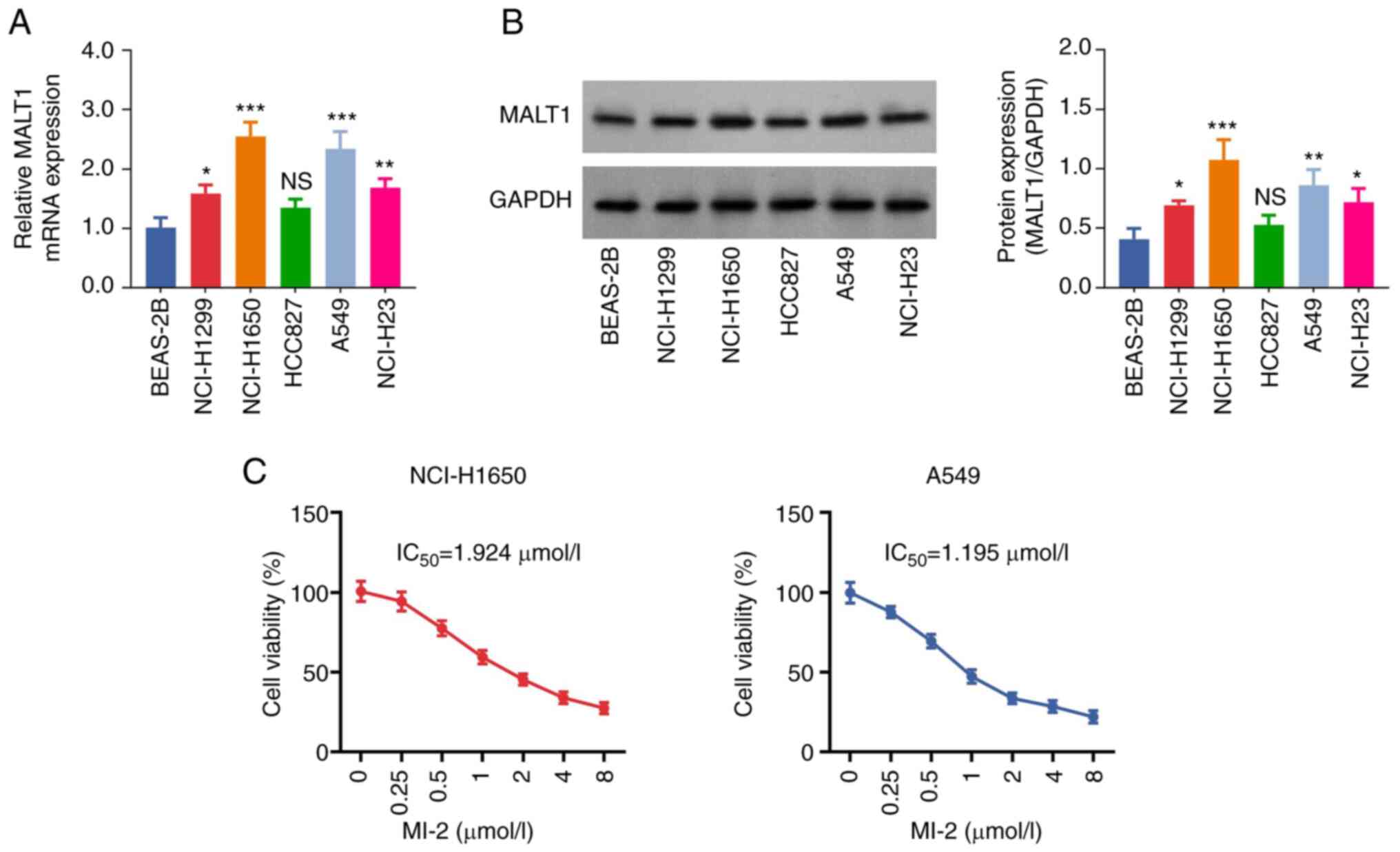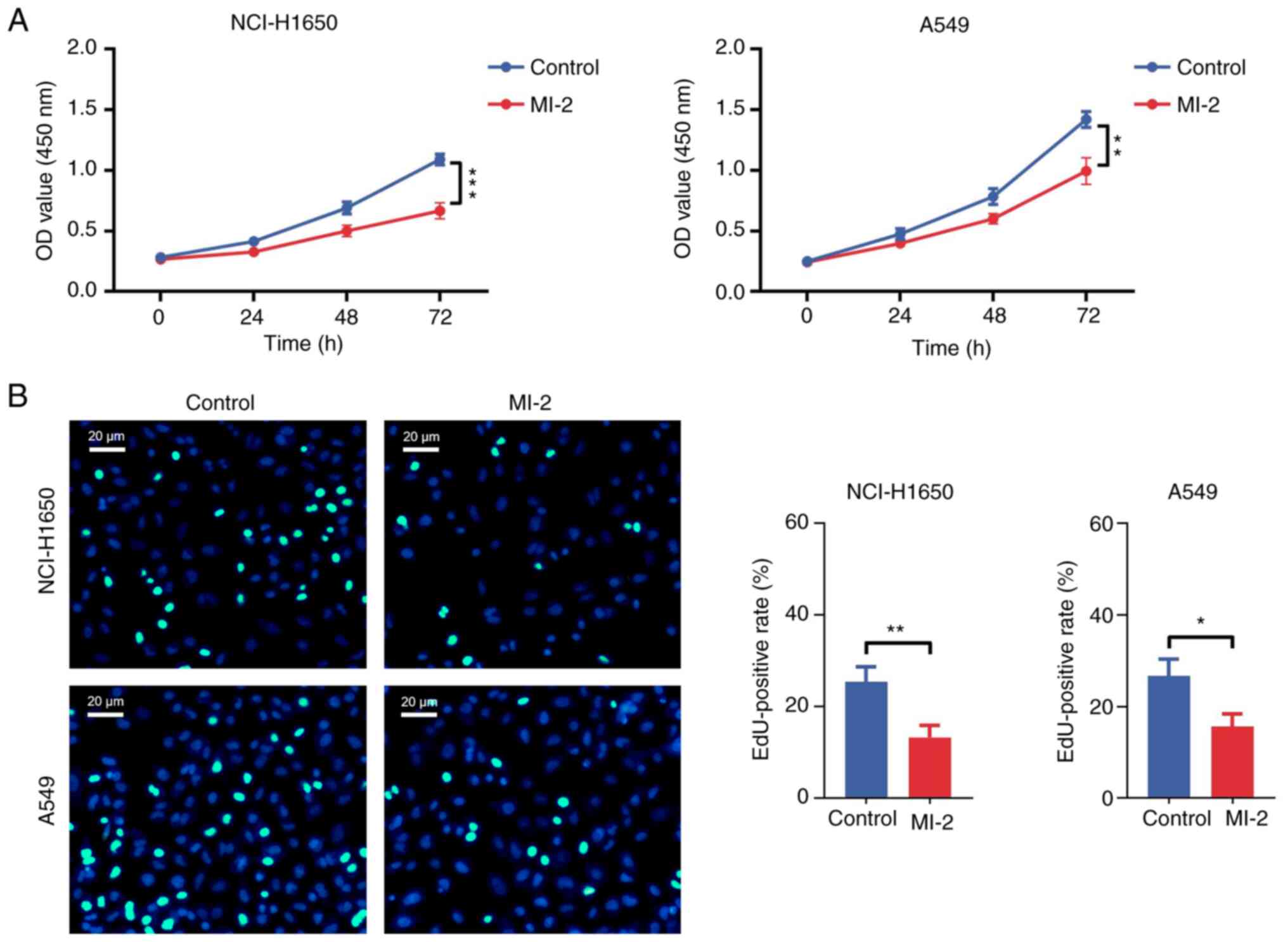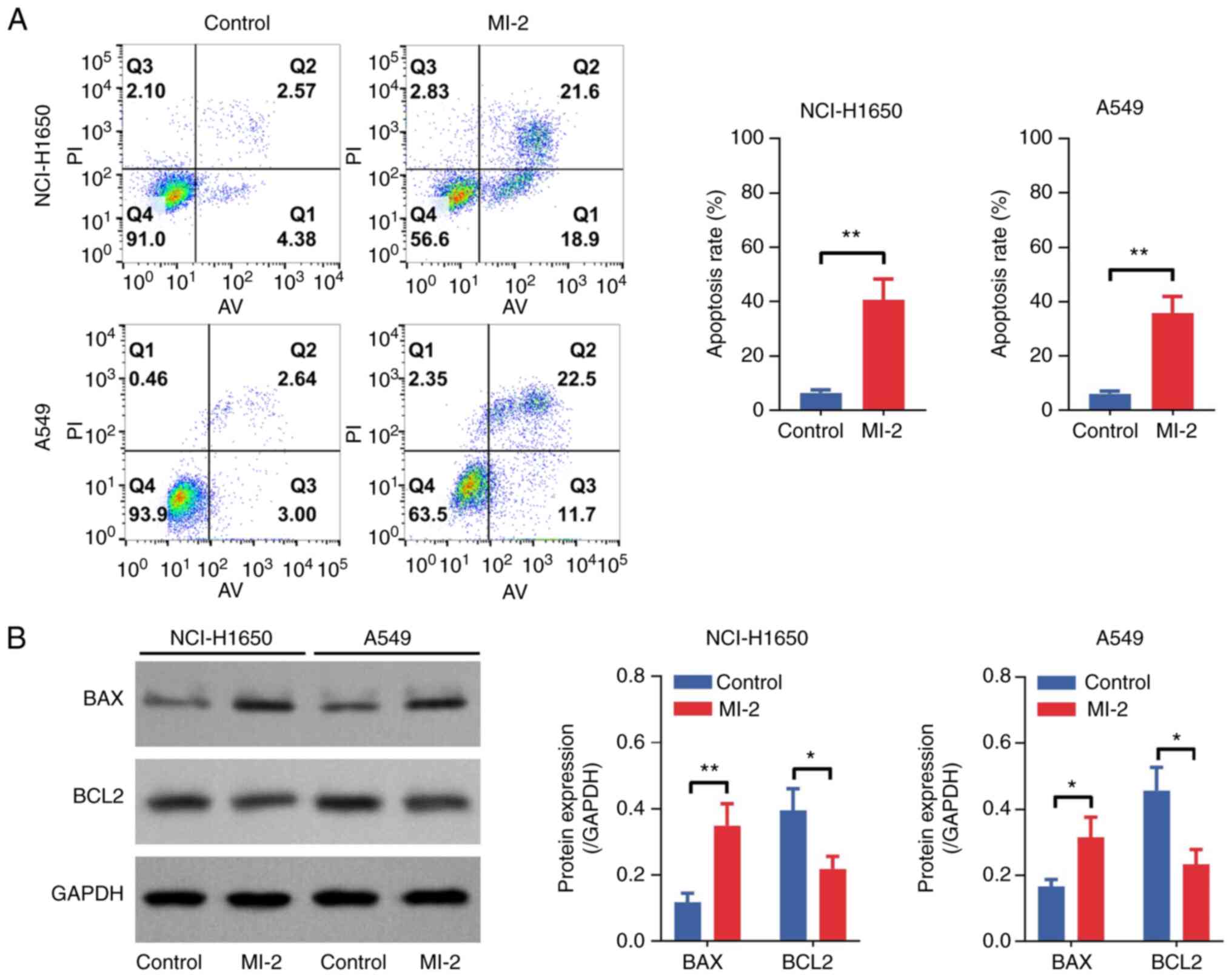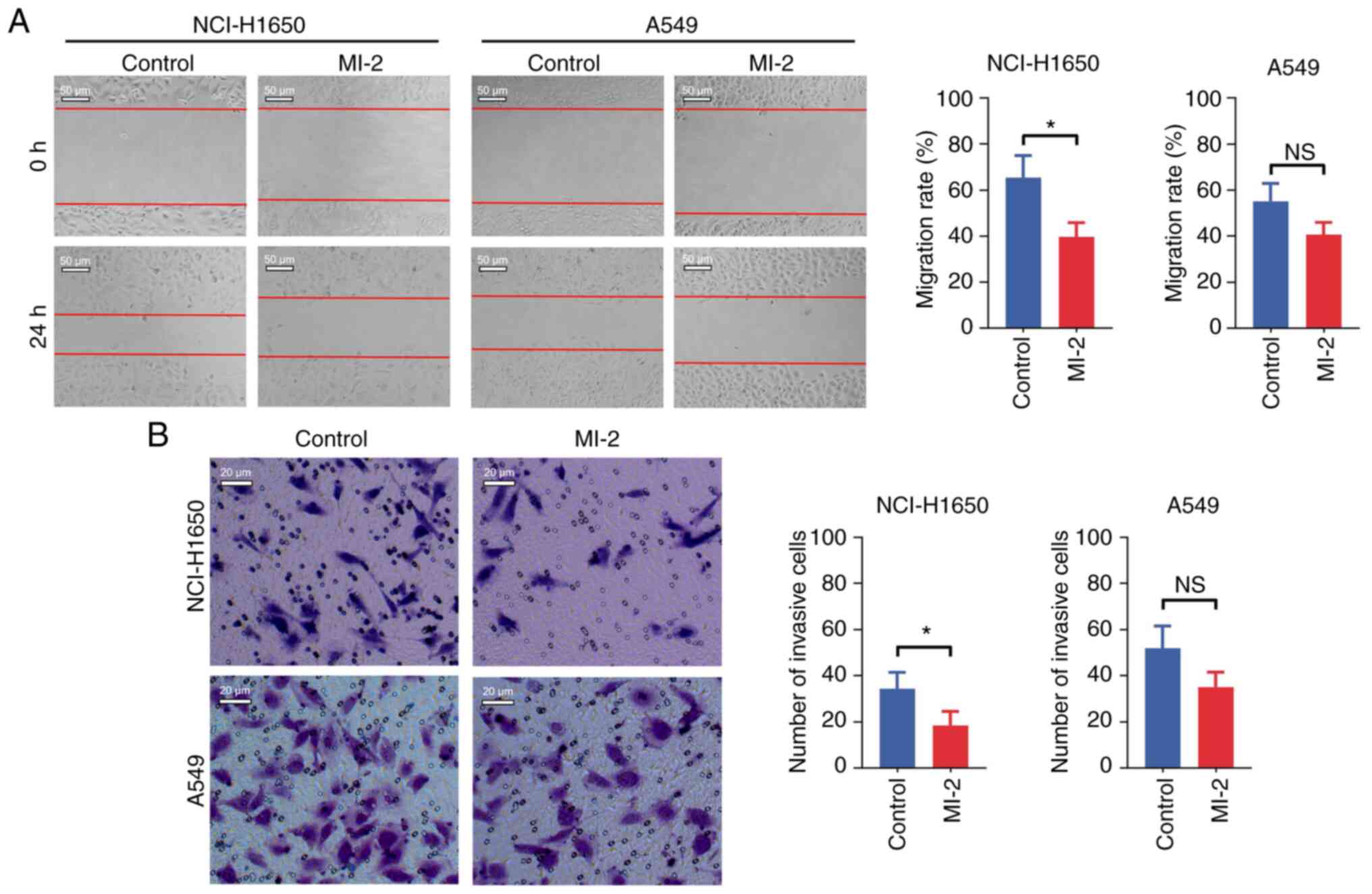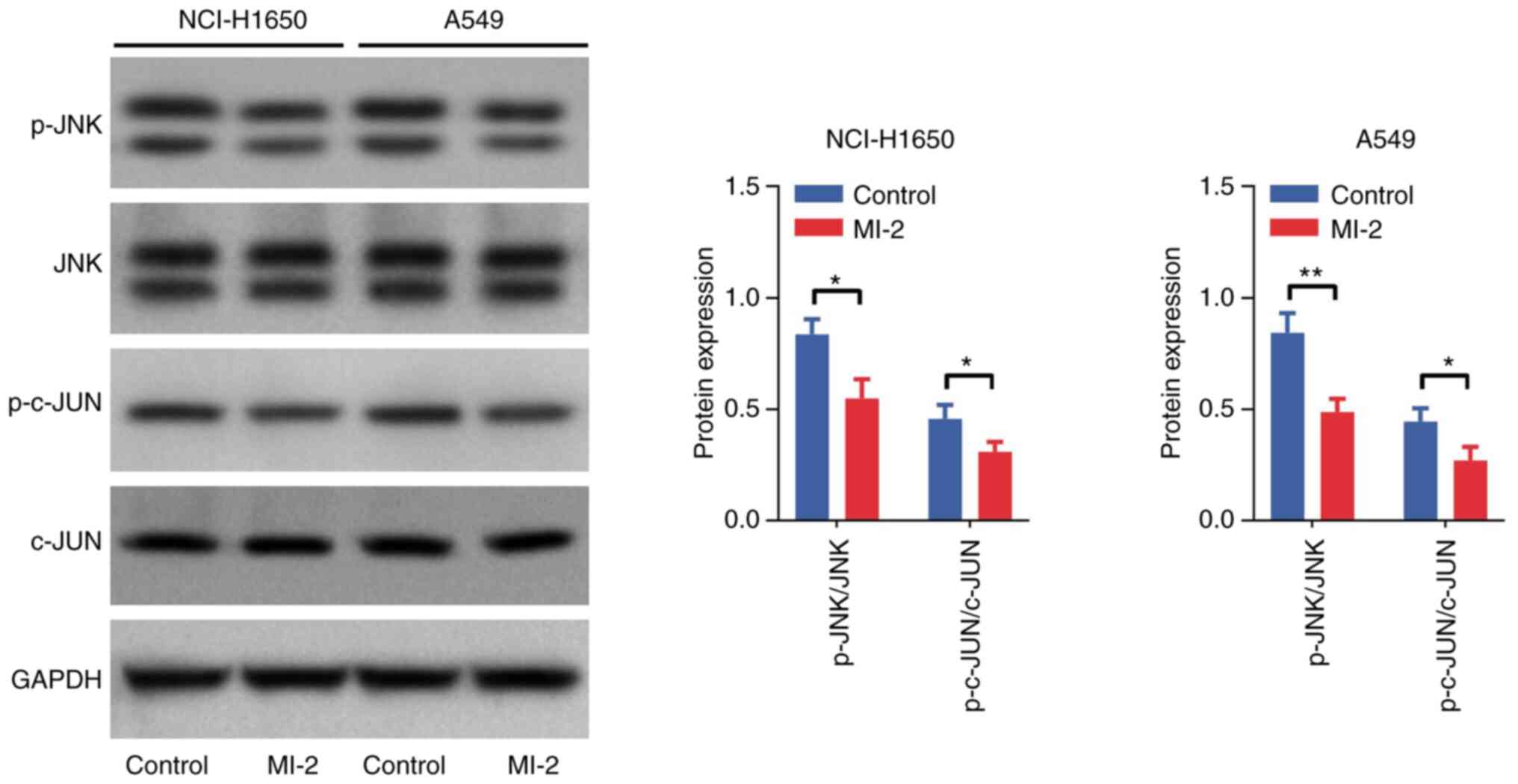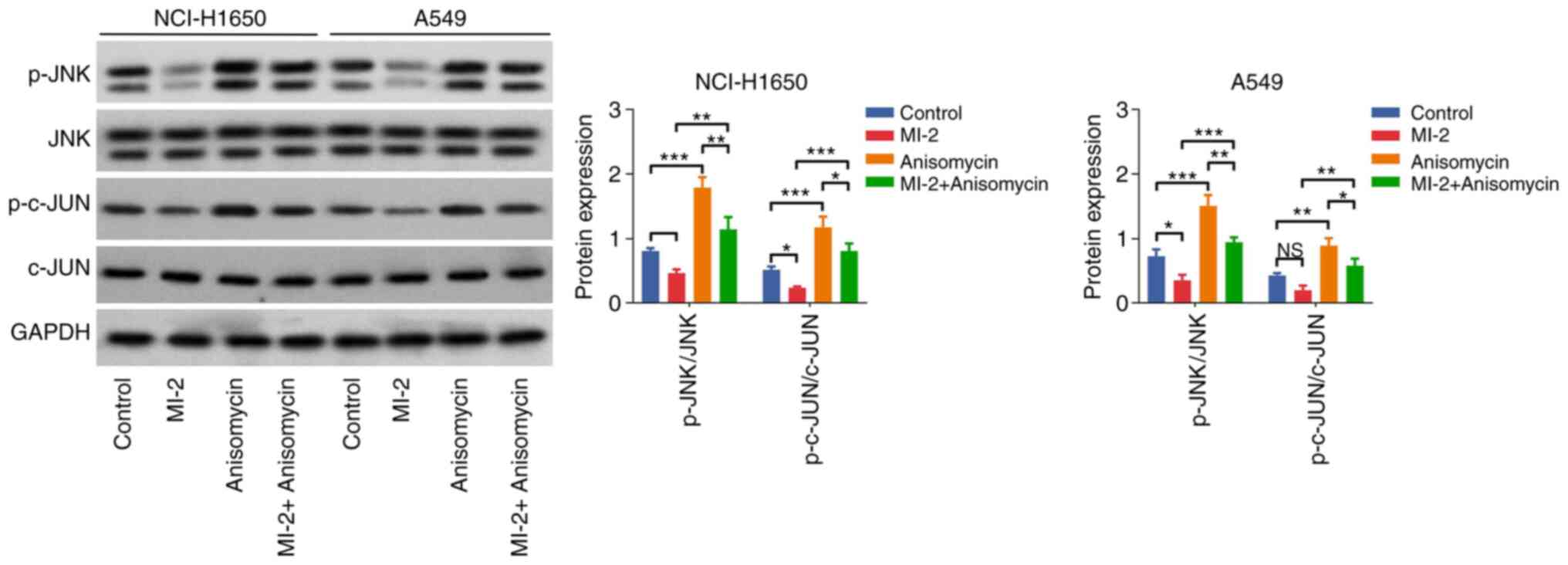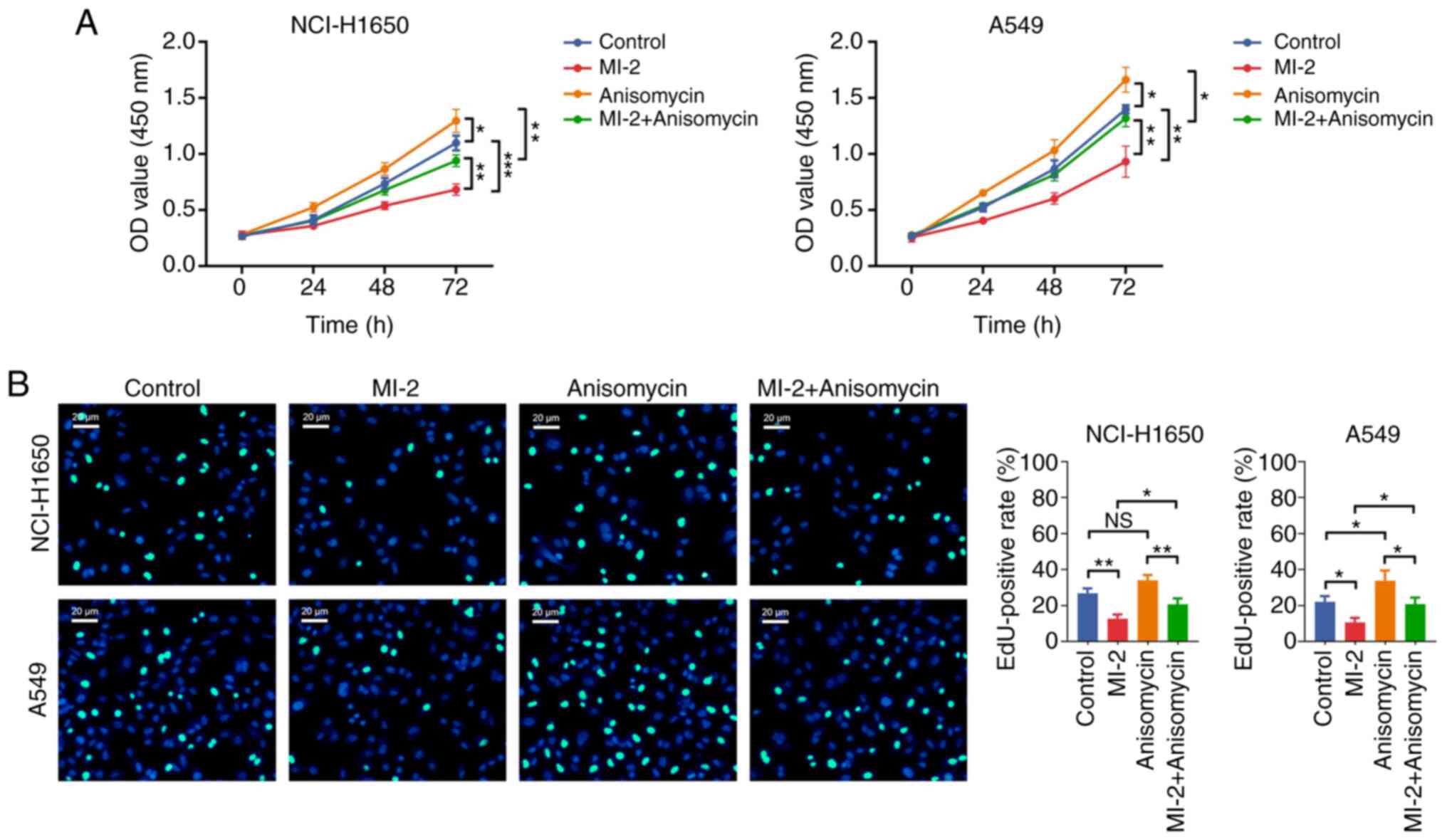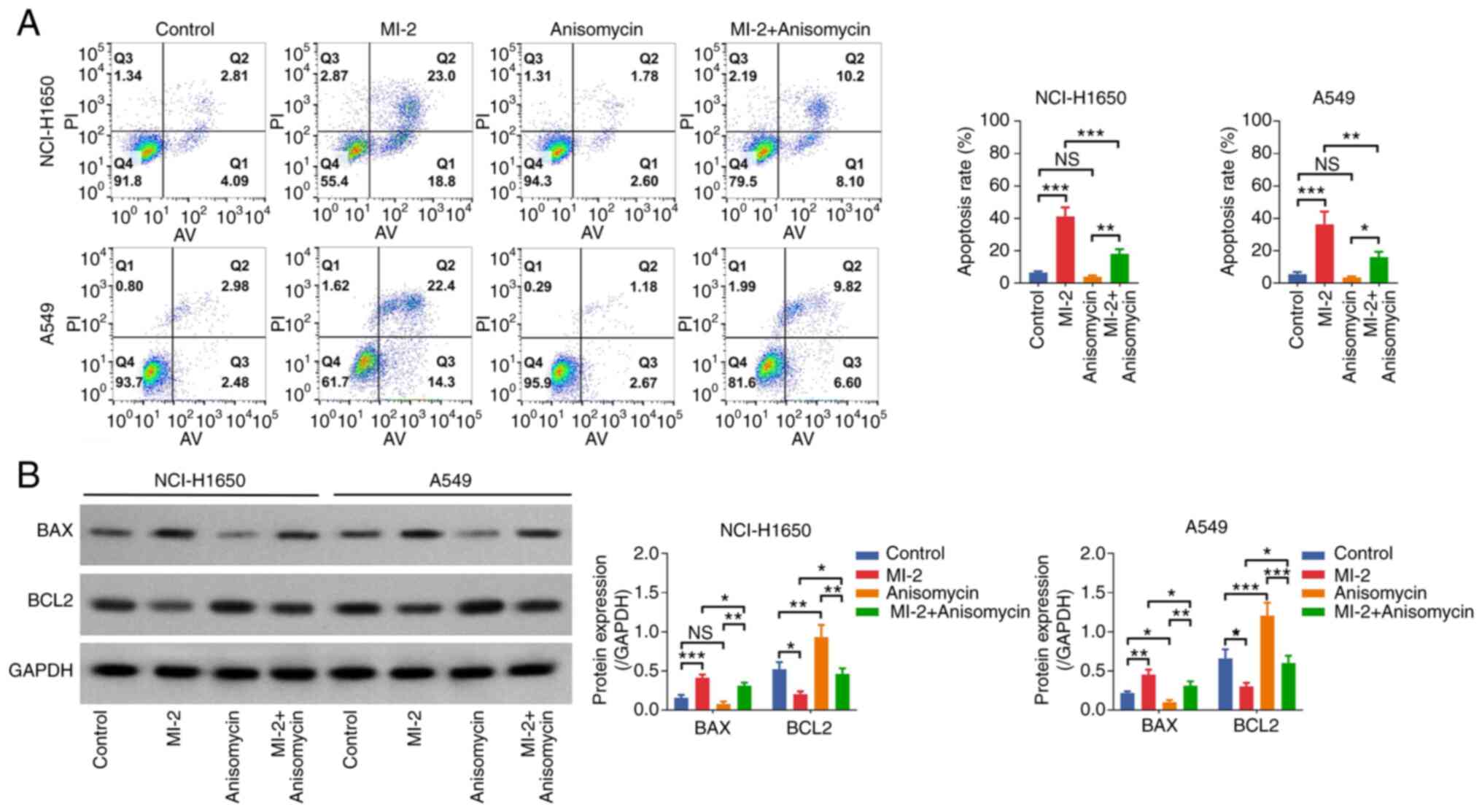Mucosa‑associated lymphoid tissue lymphoma translocation protein 1 inhibitor, MI‑2, attenuates non‑small cell lung cancer cell proliferation, migration and invasion, and promotes apoptosis by suppressing the JNK/c‑JUN pathway
- Authors:
- Published online on: July 30, 2024 https://doi.org/10.3892/ol.2024.14598
- Article Number: 465
Abstract
Introduction
Non-small cell lung cancer (NSCLC) accounts for ~85% of all diagnosed cases of lung cancer, which is a predominant cause of cancer-related deaths worldwide (1). Currently, the treatment approaches for NSCLC include surgery, chemotherapy, radiotherapy, immunotherapy and targeted therapy, which have achieved notable advances (2). However, NSCLC remains an incurable disease and a proportion of patients with NSCLC cannot benefit from the aforementioned treatment strategies, thus resulting in disease progression and severely affecting patient prognosis (3–5). In addition, the 5-year survival rate in patients with NSCLC, which ranges between 20 and 50%, remains poor (6–8). Therefore, exploring potential pharmacological agents to attenuate NSCLC progression to improve patient prognosis is of great importance.
Mucosa-associated lymphoid tissue lymphoma translocation protein 1 (MALT1) is a type of paracaspase, which is associated with the pathogenesis and progression of several types of cancer, including lung cancer (9,10). A previous study indicated that MALT1 silencing can inhibit the proliferation, migration, invasion and tumor-formation abilities of hepatocellular carcinoma (HCC) cells via hindering the nuclear factor-κB (NF-κB) pathway (11). Furthermore, another study showed that MALT1 enhances the proliferation and colony-forming abilities, and inhibits the apoptosis of prostate cancer cells, possibly due to its regulation of the NF-κB, Wnt/β-catenin and transforming growth factor β pathways (12). Additionally, a study illustrated that biperiden, a potent MALT1 inhibitor, inhibits the proliferation and accelerates the apoptosis of pancreatic ductal adenocarcinoma cells (13). In terms of lung cancer, a previous study demonstrated that MALT1 knockdown diminishes A431 and HCC827 cell migration and motility (14). Furthermore, as an integral subunit of the caspase recruitment domain family member 11/B-cell lymphoma (BCL)10/MALT1 (CBM) complex, MALT1 is a key activator of the NF-κB pathway (9). Activation of the NF-κB pathway can facilitate inflammation, and cancer cell proliferation and metastasis, which may accelerate NSCLC progression (15). Therefore, it has been hypothesized that MALT1 inhibitors may induce a suppressive effect on NSCLC. MI-2 is a strong MALT1 inhibitor that works by directly binding to MALT1 and inhibiting its protease function, and it is effective in slowing the progression of several types of cancer, such as glioblastoma multiforme and chronic lymphocytic leukemia (16–18). However, the effect of MI-2 on NSCLC is unclear and should be further explored.
The present study aimed to investigate the effect of a MALT1 inhibitor, namely MI-2, on the behavior of NSCLC cells, as well as its underlying mechanism of action.
Materials and methods
Cell culture
The BEAS-2B human normal lung epithelial cell line was provided by Beyotime Institute of Biotechnology, and the cells were cultured in Dulbecco's modified Eagle's medium (Beyotime Institute of Biotechnology) supplemented with 10% fetal bovine serum (FBS; HyClone; Cytiva). The NSCLC cell lines, NCI-H1299, NCI-H1650, HCC827, A549 and NCI-H23, were obtained from iCell Bioscience, Inc. NCI-H1299, H1650, HCC827 and NCI-H23 cells were maintained in RPMI-1640 medium (iCell Bioscience, Inc.), and A549 cells were maintained in Ham's F-12K medium (Procell Life Science & Technology Co., Ltd.). All media were supplemented with 10% FBS. All cells were grown in media supplemented with 1% penicillin/streptomycin solution (iCell Bioscience, Inc.) at 37°C in an incubator containing 5% CO2.
Reverse transcription-quantitative polymerase chain reaction (RT-qPCR)
The mRNA expression levels of MALT1 were detected by RT-qPCR. Briefly, BEAS-2B and NSCLC cells were cultured for 24 h and RNA was then extracted using the MolPure® Cell RNA Kit (Shanghai Yeasen Biotechnology Co., Ltd.). RT-qPCR was performed using the HiScript II One Step RT-qPCR Kit (Vazyme Biotech Co., Ltd.), according to the manufacturer's instructions. The thermocycling conditions were as follows: 55°C for 20 min, 1 cycle; 94°C for 3 min, 1 cycle; 94° for 30 sec, 61°C for 30 sec,72°C for 30 sec, 35 cycles; 72°C for 5 min, 1 cycle. The 2−ΔΔCq method was utilized to quantify mRNA expression levels (19). The specific primer sequences (5′-3′) used were as follows: MALT1, forward TCTTGGCTGGACAGTTTGTGA and reverse, GCTCTCTGGGATGTCGCAA; and GAPDH, forward CCATCACCATCTTCCAGGAG and reverse CCTGCTTCACCACCTTCTTG.
Assessment of the sensitivity of NSCLC cells to MI-2
The sensitivity of NCI-H1650 and A549 cells to MI-2 (MedChemExpress), a MALT1 inhibitor, was assessed using the Cell Counting Kit-8 (CCK-8) assay (MedChemExpress). Briefly, cells were seeded into a 96-well plate at a density of 3×103 cells/well and were then cultured in medium supplemented with 0, 0.25, 0.5, 1, 2, 4 or 8 µmol/l MI-2 for 24 h at 37°C. Subsequently, cells were incubated with 10 µl CCK-8 reagent for an additional 2 h. Cell viability was calculated by measuring the optical density (OD) in each well using the iMark microplate reader (Bio-Rad Laboratories, Inc.). Subsequently, the half-maximal inhibitory concentration (IC50) of MI-2 in NCI-H1650 and A549 cells was calculated using GraphPad Prism 9.0 (Dotmatics).
Cell proliferation assay
Cell proliferation was assessed using CCK-8 and 5-ethynyl-2′-deoxyuridine (EdU) staining assays. Briefly, NCI-H1650 and A549 cells were cultured and stimulated with 1 or 2 µmol/l MI-2, respectively, based on the IC50 value. A total of 0, 24, 48 and 72 h after stimulation at 37°C, the cells were supplemented with CCK-8 reagent and the OD value was measured as aforementioned. In addition, EdU staining was performed using the BeyoClick™ EdU-488 Kit (Beyotime Institute of Biotechnology). Briefly, cells were stimulated with 1 or 2 µmol/l MI-2 for 24 h at 37°C and were then stained with EdU working mixture at 37°C for 24 h, followed by fixing with paraformaldehyde (Sangon Biotech Co., Ltd.) at room temperature for 10 min and permeabilization using Triton X-100 (Beyotime Institute of Biotechnology) at room temperature for 3 min. Subsequently, the cells were successively stained with an EdU reaction mixture for 30 min and Hoechst 33342 (both from Beyotime Institute of Biotechnology) for 10 min at room temperature, according to the manufacturer's protocol. An inverted fluorescence microscope (Motic Incorporation, Ltd.) was applied to capture images.
Cell apoptosis assay
NCI-H1650 and A549 cells were stimulated with 1 or 2 µmol/l MI-2 for 24 h at 37°C and the cell apoptosis rate was determined using the Annexin V–IF488/PI Cell Apoptosis Detection Kit (Wuhan Servicebio Technology Co., Ltd.). Briefly, cells were washed and were then incubated with 5 µl Annexin V and 5 µl propidium iodide for 20 min at room temperature in the dark. Finally, cells were collected and cell apoptosis was assessed using the FACSCanto II flow cytometer (BD Biosciences) and analyzed by Flowjo X (FlowJo, LLC).
Cell migration and invasion assays
For the cell migration assay, NCI-H1650 and A549 cells were cultured to near confluence and a wound was created on the cell monolayer using a 10-µl pipette tip. Cells were then washed to remove unattached cells prior to culturing for 24 h in serum-free medium with 1 or 2 µmol/l MI-2. Images of the wound area were captured by an inverted light microscope (Motic Incorporation, Ltd.) and the cell migration rate was then calculated using the following formula: 1-wound area at 24 h/wound area at 0 h.
Additionally, cell invasion was assed using a Transwell assay. Briefly, NCI-H1650 and A549 cells at a density of 3×104 cells/well in serum-free medium supplemented with 1 or 2 µmol/l MI-2 were seeded into 24-well plates pre-coated with Matrigel, at 37°C for 1 h, on the upper inserts (Corning, Inc.) of the Transwell chamber. The lower chamber was filled with complete medium. Following incubation for 24 h, the invasive cells were stained with 0.1% crystal violet (Beyotime Institute of Biotechnology) at room temperature for 10 min and images were captured using an inverted light microscope (Motic Incorporation, Ltd.).
Western blot analysis
The BEAS-2B and NSCLC cell lines were cultured and the protein expression levels of MALT1 were determined by western blotting. In addition, NCI-H1650 and A549 cells were stimulated with 1 or 2 µmol/l of MI-2 for 24 h at 37°C, and the protein expression levels of BCL2, BCL2-associated X-protein (BAX) phosphorylated (p)-c-JUN N-terminal kinase (JNK), JNK, p-c-JUN, c-JUN and GAPDH were detected by western blot analysis. Briefly, total proteins were extracted with a Cell Lysis Buffer (Cell Signaling Technology, Inc.) and were quantified using the Total Protein Assay Kit (Nanjing Jiancheng Bioengineering Institute). Subsequently, 20 µg proteins were separated by SDS-PAGE on 4–20% gels and were electrotransferred onto PVDF membranes. The membranes were then incubated with 5% non-fat powdered milk (Beyotime Institute of Biotechnology) at 37°C for 90 min and with primary antibodies (Affinity Biosciences) against the aforementioned proteins at an appropriate dilution, according to the supplier's instructions, at 4°C overnight. Following incubation with the corresponding secondary antibodies (Affinity Biosciences) at 37°C for 2 h, the protein bands were visualized using the Super ECL Detection Reagent (Shanghai Yeasen Biotechnology Co., Ltd.). The proteins were semi-quantified by ImageJ 1.8 (National Institutes of Health). The antibodies used were as follows: Anti-BCL2 (cat. no. AF6139; 1:2,000), anti-BAX (cat. no. AF0120; 1:2,000), anti-p-JNK (cat. no. AF3318; 1:2,000); anti-JNK (cat. no. AF6318; 1:1,500), anti-c-JUN (cat. no. AF6090; 1:2,000), anti-p-c-JUN (cat. no. AF3095; 1:2,000), anti-MALT1 (cat. no. DF6867; 1:3,000), anti-GAPDH (cat. no. AF7021; 1:3,000), and Goat Anti-Rabbit IgG (H+L) HRP (cat. no. S0001; 1:5,000) (all from Affinity Biosciences).
Anisomycin treatment assay
Anisomycin (MedChemExpress), an activator of the JNK pathway, was adopted to validate the modulation of the JNK pathway by MALT1. Briefly, NCI-H1650 and A549 cells were cultured and co-stimulated with 1 or 2 µmol/l MI-2 and 0.1 µmol/l anisomycin alone or in combination; the concentration of anisomycin (0.1 µmol/l) was determined based on a previous study (20). Following treatment for 24 h at 37°C, cells were collected for western blotting, EdU staining and cell apoptosis assays, which were conducted as aforementioned. Notably, the CCK-8 assay was carried out after 0, 24, 48 and 72 h of stimulation.
Statistical analysis
All analyses were performed using SPSS 22.0 software (IBM Corp.). Experiments were repeated in triplicate and data are presented as the mean ± standard deviation. The differences among multiple groups were compared by one-way ANOVA followed by Dunnett's or Tukey's multiple comparisons test. The differences between two groups were compared by unpaired Student's t-test. P<0.05 was considered to indicate a statistically significant difference.
Results
MALT1 expression in NSCLC cell lines
The results showed that the mRNA expression levels of MALT1 were significantly increased in NCI-H1299 (P<0.05), NCI-H1650 (P<0.001), A549 (P<0.001) and NCI-H23 (P<0.01) cells compared with those in the BEAS-2B cell line. However, no significant difference was observed in the expression levels of MALT1 between HCC827 and BEAS-2B cells (P>0.05; Fig. 1A). Consistent with the RT-qPCR analysis results, western blot analysis indicated that the protein expression levels of MALT1 were increased in NSCLC cells (P<0.05; Fig. 1B). Notably, the mRNA and protein expression levels of MALT1 were highest in NCI-H1650 and A549 cells; therefore, these cell lines were chosen for subsequent experiments. Additionally, the CCK-8 assay demonstrated that the viability of MI-2-treated NCI-H1650 and A549 cells was decreased in a dose-dependent manner. The IC50 values of MI-2 in NCI-H1650 and A549 cells were 1.924 and 1.195 µmol/l, respectively (Fig. 1C).
Effect of MI-2 on NCI-H1650 and A549 cell proliferation, apoptosis, migration and invasion
The CCK-8 assay results revealed that the OD value in NCI-H1650 (P<0.001) and A549 (P<0.01) cells treated with MI-2 for 72 h was significantly decreased compared with that in the control group (Fig. 2A). In addition, the EdU staining assay showed that the EdU-positive rate was reduced in MI-2-treated NCI-H1650 (P<0.01) and A549 (P<0.05) cells compared with that in untreated cells (Fig. 2B). Furthermore, an Annexin V–IF488/PI Cell Apoptosis Detection Kit was used to determine cell apoptosis. As shown in Fig. 3A, the cell apoptosis rate was increased by MI-2 in NCI-H1650 (P<0.01) and A549 (P<0.01) cells. Furthermore, western blot analysis revealed that BAX was upregulated and BCL2 was downregulated in MI-2-treated NCI-H1650 and A549 cells compared with those in the control group (all P<0.05; Fig. 3B). In addition, the cell migration assay demonstrated that MI-2 attenuated the migration of NCI-H1650 cells (P<0.05), but not that of A549 cells (P>0.05), compared with in untreated cells (Fig. 4A). Finally, the invasive ability of NCI-H1650 and A549 cells was assessed by Transwell assays. The results indicated that MI-2 reduced the invasion of NCI-H1650 cells (P<0.05), but not that of A549 cells (P>0.05), compared with in the control group (Fig. 4B).
Effect of MI-2 on the JNK/c-JUN pathway in NCI-H1650 and A549 cells
Western blot analysis was performed to detect the protein expression levels of p-JNK, JNK, p-c-JUN and c-JUN in NCI-H1650 and A549 cells. The results demonstrated that the p-JNK/JNK and p-c-JUN/c-JUN ratios were decreased in NCI-H1650 and A549 cells treated with MI-2 compared with those in the control group (all P<0.05; Fig. 5).
Effect of anisomycin on the MI-2-mediated JNK/c-JUN pathway in NCI-H1650 and A549 cells
Furthermore, western blot analysis indicated that the p-JNK/JNK and p-c-JUN/c-JUN ratios were elevated in the anisomycin group compared with those in the control group (both P<0.001). In addition, these protein ratios were enhanced in the MI-2 + anisomycin group vs. the MI-2 group in NCI-H1650 and A549 cells (all P<0.01; Fig. 6).
Effect of anisomycin on MI-2-mediated NCI-H1650 and A549 cell proliferation and apoptosis
Subsequently, the CCK-8 assay revealed that the OD value was increased in the anisomycin group vs. the control group (both P<0.05), and in the MI-2 + anisomycin group vs. the MI-2 group (both P<0.01), in NCI-H1650 and A549 cells (Fig. 7A). The EdU staining assay demonstrated that the EdU-positive rate was not affected by anisomycin in NCI-H1650 cells (P>0.05), but it was increased in the anisomycin group compared with the control group in A549 cells (P<0.05). Consistently, the EdU-positive rate was elevated in the MI-2 + anisomycin group compared with that in the MI-2 group in both NCI-H1650 and A549 cells (all P<0.05; Fig. 7B). Additionally, the Annexin V–IF488/PI Cell Apoptosis Detection Kit showed that the cell apoptosis rate was not affected by anisomycin (both P>0.05), but it was reduced in the MI-2 + anisomycin group compared with that in the MI-2 group in both NCI-H1650 and A549 cells (both P<0.01; Fig. 8A). Western blot analysis indicated that BAX was only downregulated by anisomycin in A549 cells (P<0.05), whereas BCL2 was upregulated in both anisomycin-treated NCI-H1650 (P<0.01) and A549 (P<0.001) cells compared with in the control group. Furthermore, BAX was downregulated and BCL2 was upregulated in the MI-2 + anisomycin group compared with in the MI-2 group in both NCI-H1650 and A549 cells (all P<0.05; Fig. 8B). These findings indicated that anisomycin may enhance proliferation but attenuate apoptosis in NCI-H1650 and A549 cells. Furthermore, anisomycin weakened the effect of MI-2 on inhibiting proliferation and facilitating apoptosis in NCI-H1650 and A549 cells.
Discussion
MALT1 is an indispensable unit of the CBM complex, which regulates malignant tumor cell survival, proliferation and metastasis, and is thus involved in the pathology and progression of some types of cancer (9). It has been reported that MALT1 is upregulated in several types of cancer (11,21). For example, a previous study elucidated that MALT1 is abundantly expressed in prostate cancer tissues compared with in normal tissues (22). Another study illustrated that MALT1 is elevated in colorectal cancer (CRC) tissues compared with in adjacent normal tissues (21). In the present study, the results showed that both the mRNA and protein expression levels of MALT1 were increased in NCI-H1299, NCI-H1650, A549 and NCI-H23 cells compared with in BEAS-2B cells. These finding could be due to the fact that MALT1 promotes cell proliferation, thus suggesting that it could be involved in the malignant proliferation of NSCLC cells (11,23,24). Therefore, MALT1 was overexpressed in NSCLC cell lines compared with in normal lung epithelial cells. The identification of novel biomarkers is fundamental for the early diagnosis of NSCLC, which assists in improving the prognosis of patients with NSCLC (25–27). The present findings provided a theoretical reference that MALT1 was highly expressed in NSCLC cells compared with in normal cells, which suggested that MALT1 may possess the potential to serve as a biomarker for patients with NSCLC. However, this hypothesis should be validated by subsequent studies.
Targeting MALT1 is a potential strategy for attenuating cancer progression. Therefore, the role of MALT1 inhibitors, such as MI-2, on the progression of several types of cancer has been widely investigated (11,17,28,29). For example, a previous study reported that MI-2 can reduce A2058 and A375 melanoma cell proliferation and migration (29). Another study elucidated that MI-2 attenuates the migration, invasion and tumor-forming abilities of HCC cells, possibly via inhibiting the NF-κB pathway (11). Additionally, MI-2 can effectively inhibit glioblastoma multiforme cell proliferation, survival, migration and invasion (17), and can diminish the proliferation and migration of CRC cells (21). In the present study, the results suggested that MI-2 could reduce NSCLC cell proliferation, migration and invasion, and enhance cell apoptosis. These findings could be attributed to the possible effect of MI-2 on suppressing the activation of several signaling pathways, including the NF-κB, B cell receptor, phosphoinositide 3-kinase/protein kinase B/mammalian target of rapamycin and extracellular-signal-regulated kinase/mitogen-activated protein kinase pathways, to affect NSCLC cell proliferation, apoptosis, migration and invasion (18,24,30,31). Notably, MI-2 could only reduce migration and invasion in NCI-H1650 cells, but not in A549 cells; the reasons for this may be: i) According to a previous study, metastatic cell lines with high MALT1 expression are particularly sensitive to MI-2 (29). In addition, according to the American Type Culture Collection, NCI-H1650 cells were derived from the metastatic sites of the lung, whereas A549 cells were not. Therefore, the inhibitory effect of MALT1 by MI-2 might have a limited effect on reducing A549 cell invasion and migration compared with NCI-H1650 cells. However, further experiments are required to validate this speculation. ii) Since the number of experimental repeats was only three, the statistical power would be affected. To further confirm the findings, more experimental repeats are recommended, preferably at least five. Moreover, it should be clarified that MI-2 is a potent MALT1 inhibitor, which acts by directly binding to MALT1 and inhibiting its protease function (16). Thus, it was hypothesized that MI-2 could only inhibit the protease function of MALT1, but it could not affect its expression, which was confirmed by a previous study (32). However, this speculation should be validated by subsequent experiments.
Emerging evidence has suggested that the JNK/c-JUN pathway is closely involved in the pathology and progression of NSCLC (33–36). For example, a previous study showed that the activated JNK/c-JUN pathway promotes the growth and metastasis of lung adenocarcinoma (33). Additionally, inhibition of the JNK/c-JUN pathway accelerates NSCLC cell apoptosis (36). Furthermore, another study found that activation of the JNK/c-JUN pathway could induce NSCLC cell proliferation and migration, and attenuate NSCLC cell apoptosis (35). Regarding the regulatory effect of MALT1 on the JNK/c-JUN pathway, a previous study indicated that MALT1 activates the JNK/c-JUN pathway to facilitate melanoma cell proliferation and motility (29). However, whether the regulatory effect of MALT1 on the JNK/c-JUN pathway also participates in the progression of NSCLC remains unclear. In the current study, the results demonstrated that MI-2 suppressed the JNK/c-JUN pathway in NSCLC cells. This could be due to the fact that MI-2 can degrade the CBM complex or regulate cleavage of the deubiquitinase cylindromatosis (CYLD), thus further inactivating JNK/c-JUN signaling (23,37). In addition, the present study showed that co-treatment of NSCLC cell with anisomycin and MI-1 abrogated the effects of MI-2 on the JNK/c-JUN signaling pathway, along with its effect on NSCLC cell proliferation and apoptosis. As aforementioned, it was hypothesized that MI-2 could affect the CBM complex or CYLD cleavage, thus inactivating the JNK/c-JUN signaling pathway, ultimately attenuating NSCLC cell proliferation and promoting NSCLC cell apoptosis (23,37). However, whether the regulatory effect of MI-2 on JNK/c-JUN signaling is direct or indirect should be verified by further experiments.
In conclusion, the present study demonstrated that MI-2, a MALT1 inhibitor, could impair NSCLC cell proliferation, migration and invasion, and promote NSCLC cell apoptosis by suppressing the JNK/c-JUN pathway, which could be involved in attenuating NSCLC progression. To the best of our knowledge, this is the first study that explores the involvement of MI-2 in NSCLC, and our findings suggested that MI-2 may be helpful in attenuating NSCLC progression. Based on the findings of this study, further studies could consider exploring the effect of MI-2 on other types of cancer. Meanwhile, other potential pathways involved in the regulation of MI-2 on NSCLC could be further investigated.
Acknowledgements
Not applicable.
Funding
Funding: No funding was received.
Availability of data and materials
The data generated in the present study may be requested from the corresponding author.
Authors' contributions
CW, WG and YW contributed to the study design, collected and analyzed data, and contributed to the paper writing and reviewing. CW and WG performed the experiments. WG and YW confirm the authenticity of all the raw data. All authors have read and approved the final manuscript.
Ethical approval and consent to participate
Not applicable.
Patient consent for publication
Not applicable.
Competing interests
The authors declare that they have no competing interests.
References
|
Thai AA, Solomon BJ, Sequist LV, Gainor JF and Heist RS: Lung cancer. Lancet. 398:535–554. 2021. View Article : Google Scholar : PubMed/NCBI | |
|
Ettinger DS, Wood DE, Aisner DL, Akerley W, Bauman JR, Bharat A, Bruno DS, Chang JY, Chirieac LR, DeCamp M, et al: NCCN guidelines® insights: Non-small cell lung cancer, version 2.2023. J Natl Compr Canc Netw. 21:340–350. 2023. View Article : Google Scholar : PubMed/NCBI | |
|
Miller M and Hanna N: Advances in systemic therapy for non-small cell lung cancer. BMJ. 375:n23632021. View Article : Google Scholar : PubMed/NCBI | |
|
Wu J and Lin Z: Non-small cell lung cancer targeted therapy: Drugs and mechanisms of drug resistance. Int J Mol Sci. 23:150562022. View Article : Google Scholar : PubMed/NCBI | |
|
Wang M, Herbst RS and Boshoff C: Toward personalized treatment approaches for non-small-cell lung cancer. Nat Med. 27:1345–1356. 2021. View Article : Google Scholar : PubMed/NCBI | |
|
Rhodin KE, Rucker AJ, Ready NE, D'Amico TA and Antonia SJ: The immunotherapeutic landscape in non-small cell lung cancer and its surgical horizons. J Thorac Cardiovasc Surg. 159:1616–1623. 2020. View Article : Google Scholar : PubMed/NCBI | |
|
Ganti AK, Klein AB, Cotarla I, Seal B and Chou E: Update of incidence, prevalence, survival, and initial treatment in patients with non-small cell lung cancer in the US. JAMA Oncol. 7:1824–1832. 2021. View Article : Google Scholar : PubMed/NCBI | |
|
Sadeghirad H, Bahrami T, Layeghi SM, Yousefi H, Rezaei M, Hosseini-Fard SR, Radfar P, Warkiani ME, O'Byrne K and Kulasinghe A: Immunotherapeutic targets in non-small cell lung cancer. Immunology. 168:256–272. 2023. View Article : Google Scholar : PubMed/NCBI | |
|
O'Neill TJ, Tofaute MJ and Krappmann D: Function and targeting of MALT1 paracaspase in cancer. Cancer Treat Rev. 117:1025682023. View Article : Google Scholar : PubMed/NCBI | |
|
Gomez Solsona B, Schmitt A, Schulze-Osthoff K and Hailfinger S: The paracaspase MALT1 in cancer. Biomedicines. 10:3442022. View Article : Google Scholar : PubMed/NCBI | |
|
Kurden-Pekmezci A, Cakiroglu E, Eris S, Mazi FA, Coskun-Deniz OS, Dalgic E, Oz O and Senturk S: MALT1 paracaspase is overexpressed in hepatocellular carcinoma and promotes cancer cell survival and growth. Life Sci. 323:1216902023. View Article : Google Scholar : PubMed/NCBI | |
|
Tan H, Xie Y, Zhang X, Wu S, Zhao H, Wu J, Wang W and Lin C: Integrative analysis of MALT1 as a potential therapeutic target for prostate cancer and its immunological role in pan-cancer. Front Mol Biosci. 8:7149062021. View Article : Google Scholar : PubMed/NCBI | |
|
Konczalla L, Perez DR, Wenzel N, Wolters-Eisfeld G, Klemp C, Lüddeke J, Wolski A, Landschulze D, Meier C, Buchholz A, et al: Biperiden and mepazine effectively inhibit MALT1 activity and tumor growth in pancreatic cancer. Int J Cancer. 146:1618–1630. 2020. View Article : Google Scholar : PubMed/NCBI | |
|
Pan D, Jiang C, Ma Z, Blonska M, You MJ and Lin X: MALT1 is required for EGFR-induced NF-κB activation and contributes to EGFR-driven lung cancer progression. Oncogene. 35:919–928. 2016. View Article : Google Scholar : PubMed/NCBI | |
|
Dimitrakopoulos FD, Kottorou AE, Kalofonou M and Kalofonos HP: The fire within: NF-κB involvement in non-small cell lung cancer. Cancer Res. 80:4025–4036. 2020. View Article : Google Scholar : PubMed/NCBI | |
|
Fontan L, Yang C, Kabaleeswaran V, Volpon L, Osborne MJ, Beltran E, Garcia M, Cerchietti L, Shaknovich R, Yang SN, et al: MALT1 small molecule inhibitors specifically suppress ABC-DLBCL in vitro and in vivo. Cancer Cell. 22:812–824. 2012. View Article : Google Scholar : PubMed/NCBI | |
|
Liu X, Yue C, Shi L, Liu G, Cao Q, Shan Q, Wang Y, Chen X, Li H, Wang J, et al: MALT1 is a potential therapeutic target in glioblastoma and plays a crucial role in EGFR-induced NF-κB activation. J Cell Mol Med. 24:7550–7562. 2020. View Article : Google Scholar : PubMed/NCBI | |
|
Saba NS, Wong DH, Tanios G, Iyer JR, Lobelle-Rich P, Dadashian EL, Liu D, Fontan L, Flemington EK, Nichols CM, et al: MALT1 inhibition is efficacious in both naïve and ibrutinib-resistant chronic lymphocytic leukemia. Cancer Res. 77:7038–7048. 2017. View Article : Google Scholar : PubMed/NCBI | |
|
Livak KJ and Schmittgen TD: Analysis of relative gene expression data using real-time quantitative PCR and the 2(−Delta Delta C(T)) method. Methods. 25:402–408. 2001. View Article : Google Scholar : PubMed/NCBI | |
|
Hsieh KY, Wei CK and Wu CC: YC-1 prevents tumor-associated tissue factor expression and procoagulant activity in hypoxic conditions by inhibiting p38/NF-κB signaling pathway. Int J Mol Sci. 20:2442019. View Article : Google Scholar : PubMed/NCBI | |
|
Qian R, Niu X, Wang Y, Guo Z, Deng X, Ding Z, Zhou M and Deng H: Targeting MALT1 suppresses the malignant progression of colorectal cancer via miR-375/miR-365a-3p/NF-κB axis. Front Cell Dev Biol. 10:8450482022. View Article : Google Scholar : PubMed/NCBI | |
|
Tsui KH, Chang KS, Sung HC, Hsu SY, Lin YH, Hou CP, Yang PS, Chen CL, Feng TH and Juang HH: Mucosa-associated lymphoid tissue 1 is an oncogene inducing cell proliferation, invasion, and tumor growth via the upregulation of NF-κB activity in human prostate carcinoma cells. Biomedicines. 9:2502021. View Article : Google Scholar : PubMed/NCBI | |
|
Knies N, Alankus B, Weilemann A, Tzankov A, Brunner K, Ruff T, Kremer M, Keller UB, Lenz G and Ruland J: Lymphomagenic CARD11/BCL10/MALT1 signaling drives malignant B-cell proliferation via cooperative NF-κB and JNK activation. Proc Natl Acad Sci USA. 112:E7230–E7238. 2015. View Article : Google Scholar : PubMed/NCBI | |
|
Chiba T, Soeno Y, Shirako Y, Sudo H, Yagishita H, Taya Y, Kawashiri S, Okada Y and Imai K: MALT1 inhibition of oral carcinoma cell invasion and ERK/MAPK activation. J Dent Res. 95:446–452. 2016. View Article : Google Scholar : PubMed/NCBI | |
|
Adams E, Sepich-Poore GD, Miller-Montgomery S and Knight R: Using all our genomes: Blood-based liquid biopsies for the early detection of cancer. View (Beijing). 3:202001182022.PubMed/NCBI | |
|
Wang L, Zhang M, Pan X, Zhao M, Huang L, Hu X, Wang X, Qiao L, Guo Q, Xu W, et al: Integrative serum metabolic fingerprints based multi-modal platforms for lung adenocarcinoma early detection and pulmonary nodule classification. Adv Sci (Weinh). 9:e22037862022. View Article : Google Scholar : PubMed/NCBI | |
|
Yang J, Yin X, Zhang L, Zhang X, Lin Y, Zhuang L, Liu W, Zhang R, Yan X, Shi L, et al: Defective Fe metal-organic frameworks enhance metabolic profiling for high-accuracy diagnosis of human cancers. Adv Mater. 34:e22014222022. View Article : Google Scholar : PubMed/NCBI | |
|
Hamp I, O'Neill TJ, Plettenburg O and Krappmann D: A patent review of MALT1 inhibitors (2013-present). Expert Opin Ther Pat. 31:1079–1096. 2021. View Article : Google Scholar : PubMed/NCBI | |
|
Wang Y, Zhang G, Jin J, Degan S, Tameze Y and Zhang JY: MALT1 promotes melanoma progression through JNK/c-Jun signaling. Oncogenesis. 6:e3652017. View Article : Google Scholar : PubMed/NCBI | |
|
Jiang VC, Liu Y, Lian J, Huang S, Jordan A, Cai Q, Lin R, Yan F, McIntosh J, Li Y, et al: Cotargeting of BTK and MALT1 overcomes resistance to BTK inhibitors in mantle cell lymphoma. J Clin Invest. 133:e1656942023. View Article : Google Scholar : PubMed/NCBI | |
|
McAuley JR, Bailey KM, Ekambaram P, Klei LR, Kang H, Hu D, Freeman TJ, Concel VJ, Hubel NE, Lee JL, et al: MALT1 is a critical mediator of PAR1-driven NF-κB activation and metastasis in multiple tumor types. Oncogene. 38:7384–7398. 2019. View Article : Google Scholar : PubMed/NCBI | |
|
Zhang H, Sun G, Li X, Fu Z, Guo C, Cao G, Wang B, Wang Q, Yang S, Li D, et al: Inhibition of MALT1 paracaspase activity improves lesion recovery following spinal cord injury. Sci Bull (Beijing). 64:1179–1194. 2019. View Article : Google Scholar : PubMed/NCBI | |
|
Zhang D, Jiang Q, Ge X, Shi Y, Ye T, Mi Y, Xie T, Li Q and Ye Q: RHOV promotes lung adenocarcinoma cell growth and metastasis through JNK/c-Jun pathway. Int J Biol Sci. 17:2622–2632. 2021. View Article : Google Scholar : PubMed/NCBI | |
|
Jiang T, Wu H, Lin M, Yin J, Tan L, Ruan Y and Feng M: B4GALNT1 promotes progression and metastasis in lung adenocarcinoma through JNK/c-Jun/Slug pathway. Carcinogenesis. 42:621–630. 2021. View Article : Google Scholar : PubMed/NCBI | |
|
Luo Z, Han Z, Shou F, Li Y and Chen Y: LINC00958 accelerates cell proliferation and migration in non-small cell lung cancer through JNK/c-JUN signaling. Hum Gene Ther Methods. 30:226–234. 2019. View Article : Google Scholar : PubMed/NCBI | |
|
Tanimura K, Yamada T, Horinaka M, Katayama Y, Fukui S, Morimoto K, Nakano T, Tokuda S, Morimoto Y, Iwasaku M, et al: Inhibition of c-Jun N-terminal kinase signaling increased apoptosis and prevented the emergence of ALK-TKI-tolerant cells in ALK-rearranged non-small cell lung cancer. Cancer Lett. 522:119–128. 2021. View Article : Google Scholar : PubMed/NCBI | |
|
Staal J, Driege Y, Bekaert T, Demeyer A, Muyllaert D, Van Damme P, Gevaert K and Beyaert R: T-cell receptor-induced JNK activation requires proteolytic inactivation of CYLD by MALT1. EMBO J. 30:1742–1752. 2011. View Article : Google Scholar : PubMed/NCBI |



